Different types of icing
We get so many questions in the shop and on our courses about different icings and what are their best uses.

Your definitive guide to icings
Hopefully this will now be your definitive guide to icings from sugar paste to Mexican paste, from royal icing to pastillage; what they are and when to choose them. Our Buttercreams & icings recipe card provides recipes for buttercream, frosting, chocolate fudge icing, royal icing, pastillage and more. Our Meringue buttercreams recipe card gives recipes for Italian and Swiss meringue buttercreams including vegan options, flavouring, storage and how to rescue 'split' meringue buttercream. We also have a PDF Icings recipe card.
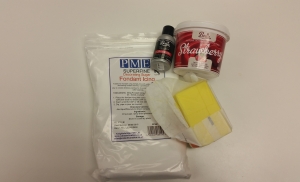
Butter cream
Made with butter and icing sugar this may be flavoured for example with lemon zest or chocolate. The beau flavourings also work superbly (our current favourite is the butterscotch). Buttercream is perfect for delicious cake fillings and for a crumb coat. We often use fondant icing powder instead of icing sugar as this produces a smoother, less gritty buttercream. You can buy ready made buttercreams. Find out why we don’t use buttercream to pipe our cupcakes…

Frosting
This is what we use to pipe swirls on top of cupcakes. If you use buttercream often the swirls do not hold their shape. Frosting is similar to buttercream but it benefits from the addition of Meri-White (a pasteurised dried egg white). The Meri-White adds stability to the frosting so when you pipe your swirls they hold their shape, even on a warm day. For white frosting use Trex (a white vegetable fat) with flavours. White frosting also is better if you need to add colour; if you use butter which is yellow if for example you wanted baby blue it would turn green or if you wanted pink it would turn a salmon colour. We run lots of cupcake courses
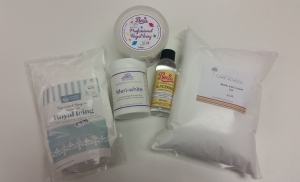
Royal icing
This is a pure white icing that dries to a smooth, hard, matte finish and it is the most traditional of all icings. Classically it is made with egg whites and icing sugar however we would always recommend using Meri-White because by using this pasteurised egg white you eliminate any potential health risks associated with using fresh egg white and you also achieve more consistent results. If you prefer you can buy a powder mix or ready-made royal icing in tubs.
Royal icing is used to create the traditional snow scene Christmas cakes, it may be used to ice cakes and it is perfect for adding piped detail such as dots or swirls and for piping messages. This is also the perfect medium for sticking gingerbread houses together and adding the snow and icicles. Royal icing can also be used to create piped flowers.
You can colour royal icing with concentrated paste or liquid colours. Glycerine is often added to prevent the icing from setting too hard. When placing icing on cakes, marzipan is usually used under the royal icing in order to prevent discoloration of the icing. If you would like to know more about royal icing why not try our piping skills course.
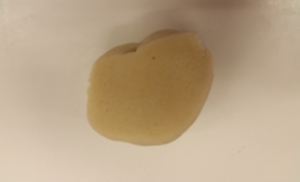
Marzipan
This forms an ideal base beneath poured fondant or poured chocolate toppings. Choose a good quality marzipan with an almond content of at least 25%. Marzipan can also be coloured for modelling (hello petit fours!) or cut outs. We use marzipan on our Back to basics course

Sugar paste
Also known as rolled fondant, fondant, roll out icing, Regal Ice (or any of the other many brands available), covering paste and in South Africa it is known as plastic icing!
This is the roll out icing you can use to cover cakes. You can also use it to top cupcakes and cookies. Although it is possible to make this yourself the commercial brands provide consistent results that taste great & life really is too short to make your own sugar paste.
This comes in a rainbow of colours as well as classic white or you can create your own shades using concentrated paste or gel colours. We would not recommend using liquid colours (changes the consistency) or dust colours (almost impossible to get an even mix).
Knead the icing to make it pliable and easy to roll out and dust surfaces with cornflour to prevent sticking.
To learn how to achieve a really smooth, professional finish we have lots of courses including One Day Professional Cake Decorating
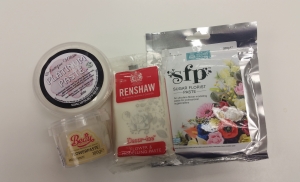
Flower paste (also known as petal paste or gum paste)
A very elastic and strong icing that can be coloured in the same way as Sugar Paste; it is perfect for making butterflies, flowers, stars etc because you can roll it finely and it holds its shape once dry.
The best way to dry your flower paste creations is on a foam sheet which allows air to easily circulate and dry evenly, preventing distortion. We recommend dusting the foam with a little cornflour to prevent sticking.
Again you could make your own flower paste, but proprietary brands are far easier and give wonderful results.
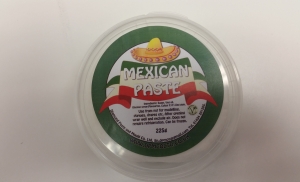
Mexican Paste
This is a very strong but also very elastic paste; it is much more stretchy than flower paste. It is also a much whiter paste. I think of it as the 'Rolls Royce' of icings! Because it is so elastic you can roll it incredibly thinly quite literally as thin as a sheet of paper if wished. I use Mexican paste when I am working with Patchwork cutters, it also works well in the smaller, more intricate moulds. It is perfect in the FMM tappit cutters and the JEM lacy butterflies and angel snowflakes. When making clothes for models Mexican paste is the ideal choice.
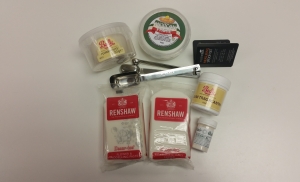
Modelling paste
This is strengthened sugar paste. It can be made by mixing equal quantities of sugar paste and a strong icing such as flower paste, Mexican paste or pastillage together or you can add 1 teaspoon of either gum tragacanth or CMC to 250g sugar paste.
When making your own modelling paste it is very important that the ingredients are kneaded until thoroughly combined. Alternatively, ready mixed modelling paste may be purchased in a tub or pack.
Modelling paste is suitable when you do not want an icing that sets too hard but one that will hold its shape better than sugar paste alone. As well as being used for modelling it also works well in moulds and when creating frills, ruffles, bows and swags.
To learn more take a look at our modelling techniques course.
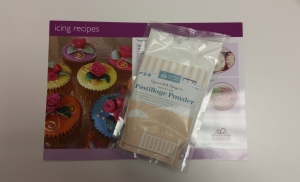
Pastillage
This is a very hard setting icing; perfect for structures such as castle turrets (see our Fairy castle instruction card) or if you need a solid shape to set firm e.g. handles on a handbag. It doesn’t have much stretch so wouldn’t be suitable for modelling or flower making.
You can buy pastillage as a powder mix or make your own from royal icing, gum tragacanth and icing sugar. The recipe is on our icings recipes card.
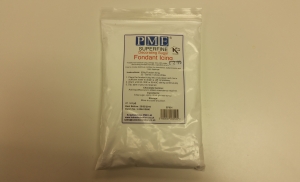
Poured fondant
Used to top cupcakes and on fondant fancies this is made by heating fondant icing powder which is mixed with water or stock syrup over a bain marie to approx. 38°. It is easy to colour and dries to a smooth and very shiny finish.

Glace icing
Glace icing is made by mixing icing sugar with a liquid such as water or fruit juice. This doesn’t give particularly professional results but you can drizzle it on top of a sponge or cupcakes and it is ideal for an afternoon in the kitchen with the children.
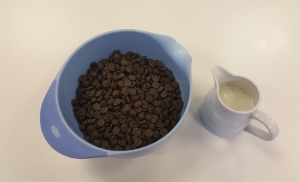
Ganache
Made with Belgian chocolate and double cream; decadence doesn’t really explain how amazing this rich cake covering and filling is. The recipe is on our rich chocolate recipe card.
This may be poured over cakes to achieve a smooth shiny chocolate finish, used to top cupcakes or once cool you can whisk the ganache to make a delicious alternative to buttercream to fill and crumb coat cakes, yummy!
De-mystify the art of chocolate with one of our courses.
So there you have it...
...all you ever wanted to know about icings and when to use them.
If you’d like more help on getting the best results ask below in the comments, or book into one of our cake courses in the UK where we can show you everything you want to know.
